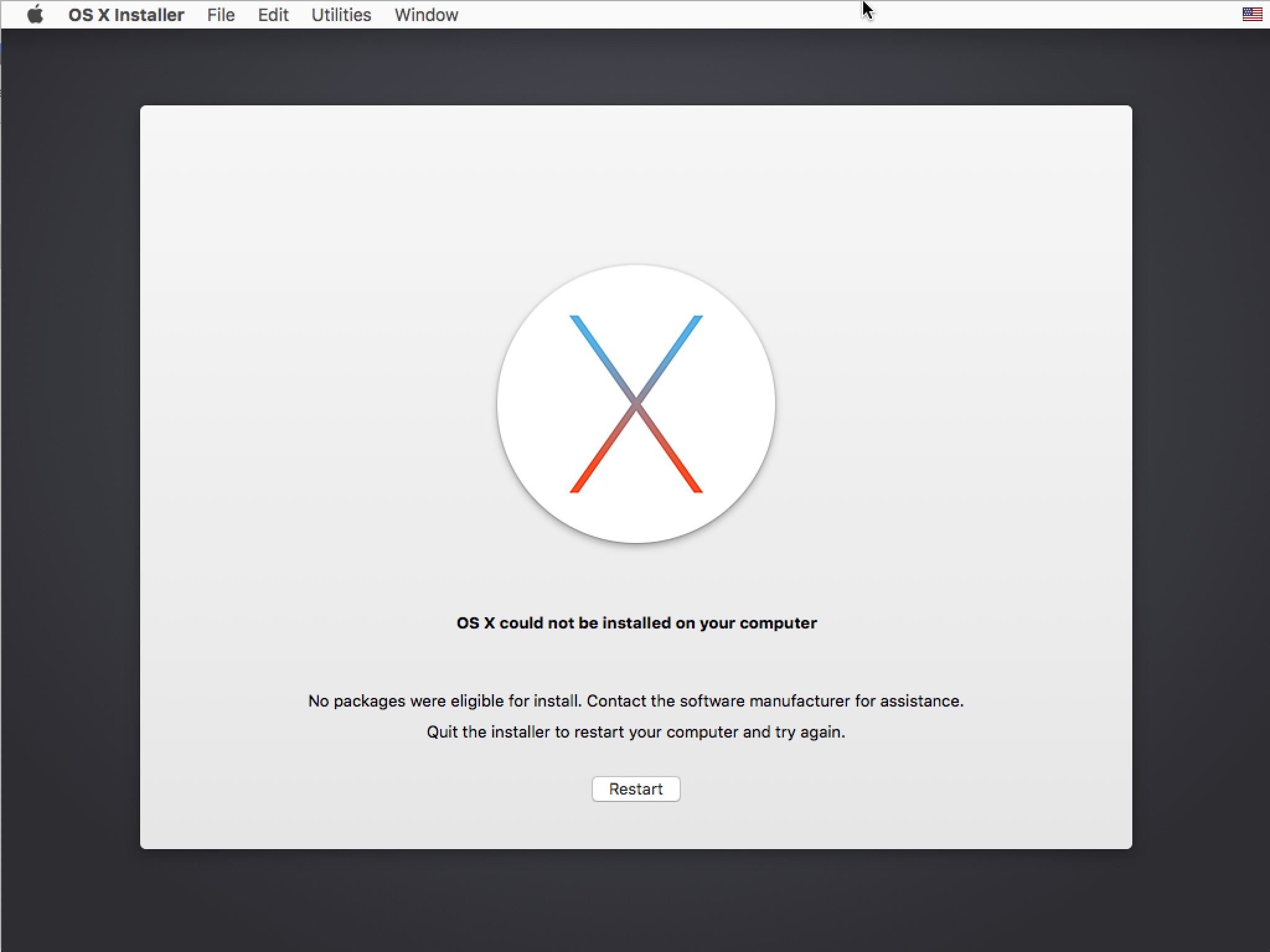- No Packages Were Eligible For Install Mac App
- How Do You Fix No Packages Were Eligible For Install
- Macos Sierra No Packages Were Eligible For Install
No packages were eligible for the install. Contact the software amnufacturer for assistance. Quit the installer to restart your computer and try again.' Click to expand. If you're connected to the internet, disconnect it. Re-create the Bootable USB and try installing. Make sure you erase the drive, not the partition. No packages were eligible for install. Contact the software manufacturer for assistance. Quit the installed to restart your computer and try again. I tried using 'Internet Recovery' (Option+Command+R) and a bootable USB drive that contained El Capitan, both of which ultimately failed with the same message. Is there a way to get this to work? It was acting up so decided a re-install was the best way to go. Followed the instructions and all went well until it it restarted. Message says” OS X could not be installed on your computer”, “No packages were eligible for install. Contact the software manufacturer for assistance. “Quite the installer restart your computer and try.
If you ever get this error while attempting to install OS X, you will likely need to set the date using terminal.The simplest way to set it (if you have no OS installed on the machine) is to boot the install media, open the terminal and check the date (type date).
The following information was found on someones site (sorry I forget which), but I have included it here to make it easier to correct this issue.
Use the following command in terminal to set the machine to a time and date of your choosing:
date {month}{day}{hour}{minute}{year}
For example, to set it to 8pm on the 2nd October 2018
date 100220002018
The command below will output the current date in a format suitable for use on another machine:
date '+%m%d%H%M%Y.%S'
 Further, the following (mouthful of a command) will let you specify a date and time in a more readable format and set it in one go:
Further, the following (mouthful of a command) will let you specify a date and time in a more readable format and set it in one go:date -f '%Y-%m-%d %H:%M:%S' '2016-07-09 15:20:10' ; Date: Sun Oct 16 2016
Tags: Mac OS X
A key step for upgrading the disk on a MacBook Pro is to install a new operating system on the new drive, and then use Migration Assistant to copy over the old data. Depending on how you went about the work, installing Mac OS X on the new system may give you a message: OS X could not be installed on your computer. No packages were eligible for install.
This is what it looks like in the installer. Upon seeing this I went 'HUH?' because the installation was from a thumb drive I'd used many times to install Mac OS X (El Capitan) successfully.
The above image came from an attempt to install El Capitan. I just got the following message, macOS could not be installed on your computer, while trying to install macOS High Sierra.

In both cases there was the same cause. In the El Capitan case, as I say in the next paragraph, the hardware clock had reset to zero because it did not have a battery pack. In the High Sierra case, I had performed a hardware reset of the computer in an attempt to fix a bootup problem. I had found advice to disconnect the battery, the power supply, then hold down the power key for a few moments. In both cases the hardware clock had been reset to zero, and macOS refused to boot.
After some yahoogling (duckduckgoing) I came across a simple solution. This particular computer had been running with no battery, and therefore the hardware clock was reset to zero, and Mac OS X had a test against that condition.
We've discussed elsewhere the process to install Mac OS X onto a computer, and transfer information from an old drive. It's during that process when the above message appears. A couple steps prior is where you can take action to correct the problem.
At this step, click on Terminal ...
Then change the operating system date.
When running this particular Terminal session, you are ROOT meaning you can change anything on the computer. Normally we type 'date' at the command line just to find out the current day/month/year/time. But, the date command can be used to change the time registered in the system clock.

As I said above, for this particular computer the system clock had been reset to zero because the battery pack had been changed. In fact, the computer had run without a battery for many months because the old battery had gone bad.
As you see on the screen, the date had been January 1, 2001. I then changed the system date to the current time as of the writing of this posting.
To understand the second command, go to a terminal window and type 'man date'.
In the synopsis section you'll see this as an option for the 'date' command:
No Packages Were Eligible For Install Mac App
That's a little obtuse, but further down the manpage is this key:
In other words, the date code for this purpose is month-day-hour-minutes-year ... hence, that's what I entered and it changed the system date to match.
How Do You Fix No Packages Were Eligible For Install
Afterward I closed the Terminal window and was able to successfully install Mac OS X on the computer.